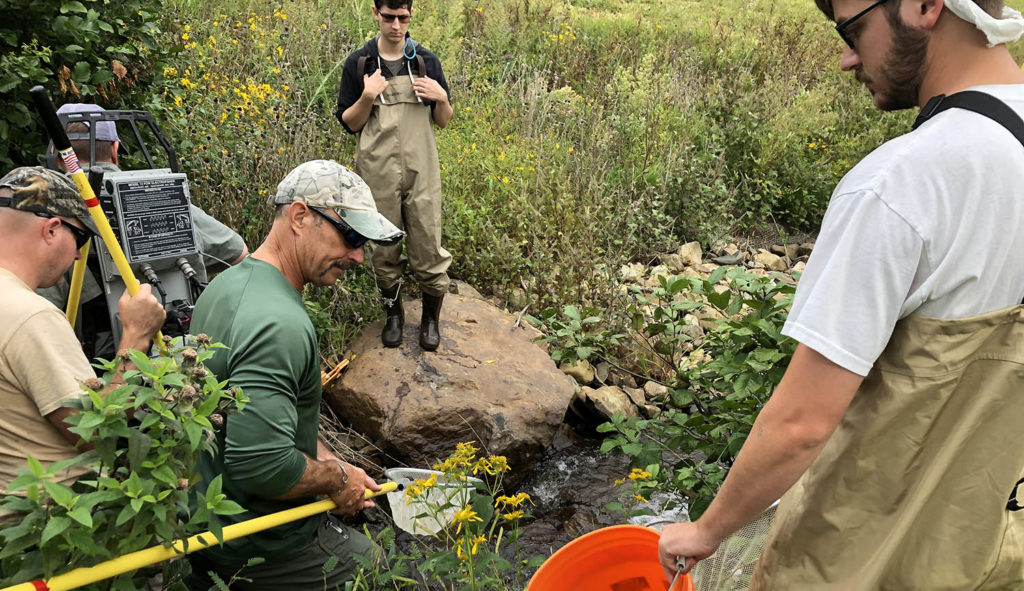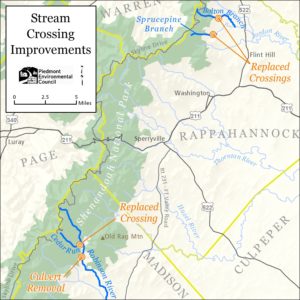
*Press Release*
SYRIA, VA. (Oct. 22, 2020) – As part of a regular monitoring effort with Virginia Department of Wildlife Resources fish biologists, the Piedmont Environmental Council last month counted 36 brook trout on either side of the fish-friendly metal truss bridge installed over Cedar Run at the Whiteoak Canyon Trailhead in November 2019. The bridge replaced an old, undersized culvert that was impeding the ability of Virginia’s state fish to reach its spawning grounds upstream. “Trout habitat has become increasingly fragmented by inadequate and failing culverts at road stream crossings, loss of tree-canopy cover and pollution from sediment in streams. Last month’s count signifies the successful impact of PEC’s stream restoration pilot efforts and paves the way for expanding the initiative more broadly,” said PEC Field Representative Claire Catlett.
Brook trout are beloved by local anglers for their flashy color, a bold speckle of red, blue, and yellow with white-tipped fins. “Brook trout, our state fish and only native salmonid, are an iconic species requiring water quality of the highest standard and providing exquisite recreational value,” said John Odenkirk, a VA-DWR fisheries biologist. “Even though brook trout strongholds in northern Virginia are generally confined to Shenandoah National Park and Rapidan Wilderness Management Area, it’s heartening to see these fish in lower elevation stream reaches like White Oak Canyon, indicating excellent water quality and stewardship,” he said.
In 2013, PEC embarked on a survey of 141 road-stream crossings in headwater streams bordering Shenandoah National Park in Madison, Rappahannock, Greene and Albemarle counties. The survey identified which crossings were impeding trout access to upstream spawning grounds and allowed PEC to prioritize projects based on habitat connectivity and water quality improvement opportunities. PEC’s survey led to a multi-partner initiative that began with four pilot projects, including the Cedar Run crossing at Whiteoak Canyon Trail.
“Our fish count at Whiteoak Canyon revealed a trout paradise there, with 22 brook trout counted downstream of the new bridge and 15 trout counted upstream,” Catlett said. “We clipped the adipose fins of the downstream brookies to track their movement from downstream to upstream. Also, several trout weighed in at 150-plus grams and over nine inches in length, a sign of a diverse age population, which is good for genetics and an indication of sustained habitat,” she said. The monitoring team also found torrent suckers, bluehead chub, mottled sculpin, longnose dace, and blacknosed dace, “all good signs of the clean water and healthy stream habitat that we hope for in headwater streams,” said Catlett.

Other exciting findings at the site included two large American eels weighing more than 200 grams each. “One eel was dark, a sign of age and maturity, and that one was likely on its way back to the Sargasso Sea as a silver eel,” Catlett said. American eel are listed as a priority species for recovery in the Rappahannock-Rapidan Watershed and the Chesapeake Bay by the U.S. Fish and Wildlife Service due to dramatic losses of eel populations from dams on major rivers built in the 19th and 20th centuries. The eel can live up to 30-50 years and will make one round-trip from its breeding grounds in the Sargasso to Appalachian headwater streams during its lifetime. Since the Embrey Dam was removed on the Rappahannock near Fredericksburg in 2004, American eel have rebounded locally, making the Shenandoah National Park and surrounding counties rich in this rare species.
In partnership with U.S. Fish and Wildlife Service, Trout Unlimited, VA Department of Wildlife Resources, and private landowners, PEC in 2017 also removed an inadequate culvert on the Robinson River in Madison County. There, the monitoring team last month counted four young trout, healthy eels, bluehead chub, rosyside dace, mottled sculpin, torrent suckers, and blacknose dace. “This project reconnected just over five miles of trout habitat and restored 350 feet of stream damaged by an undersized culvert that was basically acting as a dam,” said PEC Habitat Restoration Specialist Celia Vuocolo. “Our team’s recent findings of a vibrant and diverse fish community shows that this restoration work is doing exactly what we want it to do; it’s providing habitat and allowing for movement of native aquatic species,” she said.
PEC’s largest trout stream restoration project to date is at Bolton Branch in Rappahannock County. Partners here replaced a driveway crossing with a fish-friendly bridge and improved nearly 800 linear feet of trout habitat with constructed riffles and pools. Since completion of this project in summer 2019, the stream’s aquatic community improved almost immediately. Brook trout counts here have grown some 32-to-38 percent throughout the stream’s restoration area. The recent 2020 surveys found a newly formed population of 11 brook trout in the downstream restoration area, with a healthy amount of adults and “young of the year,” or juvenile trout.
The much smaller Sprucepine Branch in Huntly is showing all the necessary indicators for trout—cold water, good stream bugs that are important food for fish, and good water levels in the stream this year. In addition, like Cedar Run and Robinson River, Sprucepine and Bolton Branch are now hosting plenty of species that trout get along with well, including bluehead chub, rosyside dace, longnose dace, blacknose dace, torrent suckers, and mottled sculpin.
“This series of pilot projects and our findings this fall have successfully set the stage for a more broad-based stream- and habitat-restoration strategy along the eastern side of the Blue Ridge,” Vuocolo said. “We are excited about continuing our work with Trout Unlimited, VDOT, Shenandoah National Park and other partners at other trout stream locations. PEC is currently in the process of planning out the next five years of our trout initiative, and we look forward to building upon all the restoration work that we and our partners have done over the past six years.”
#####
Since 1972, The Piedmont Environmental Council has proudly promoted and protected the natural resources, rural economy, history and beauty of the Virginia Piedmont. PEC empowers residents to protect what makes the Piedmont a wonderful place, and works with citizens to conserve land, improve air and water quality and build thriving communities. PEC is a 501(c)(3) non-profit and accredited land trust. Learn more at www.pecva.org
